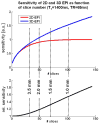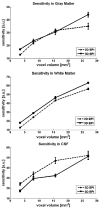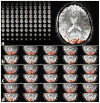Three dimensional echo-planar imaging at 7 Tesla
- PMID: 20139009
- PMCID: PMC2853246
- DOI: 10.1016/j.neuroimage.2010.01.108
Three dimensional echo-planar imaging at 7 Tesla
Abstract
Functional MRI (fMRI) most commonly employs 2D echo-planar imaging (EPI). The advantages for fMRI brought about by the increasingly popular ultra-high field strengths are best exploited in high-resolution acquisitions, but here 2D EPI becomes impractical for several reasons, including the very long volume acquisitions times. In this study at 7 T, a 3D EPI sequence with full parallel and partial Fourier imaging capability along both phase encoding axes was implemented and used to evaluate the sensitivity of 3D and corresponding 2D EPI acquisitions at four different spatial resolutions ranging from small to typical voxel sizes (1.5-3.0 mm isotropic). Whole-brain resting state measurements (N=4) revealed a better, or at least comparable sensitivity of the 3D method for gray and white matter. The larger vulnerability of 3D to physiological effects was outweighed by the much shorter volume TR, which moreover allows whole-brain coverage at high resolution within fully acceptable limits for event-related fMRI: TR was only 3.07 s for 1.5 mm, 1.88 s for 2.0 mm, 1.38 s for 2.5 mm and 1.07 s for 3.0 mm isotropic resolution. In order to investigate the ability to detect and spatially resolve BOLD activation in the visual cortex, functional 3D EPI experiments (N=8) were performed at 1 mm isotropic resolution with parallel imaging acceleration of 3x3, resulting in a TR of only 3.2 s for whole-brain coverage. From our results, and several other practical advantages of 3D over 2D EPI found in the present study, we conclude that 3D EPI provides a useful alternative for whole-brain fMRI at 7 T, not only when high-resolution data are required.
Copyright (c) 2010 Elsevier Inc. All rights reserved.
Figures



Similar articles
-
Improved temporal resolution for functional studies with reduced number of segments with three-dimensional echo planar imaging.Magn Reson Med. 2014 Sep;72(3):786-92. doi: 10.1002/mrm.24975. Epub 2013 Oct 17. Magn Reson Med. 2014. PMID: 24136782
-
Rapid whole-brain resting-state fMRI at 3 T: Efficiency-optimized three-dimensional EPI versus repetition time-matched simultaneous-multi-slice EPI.Neuroimage. 2017 Dec;163:81-92. doi: 10.1016/j.neuroimage.2017.08.031. Epub 2017 Sep 18. Neuroimage. 2017. PMID: 28923276
-
Non-Cartesian 3D-SPARKLING vs Cartesian 3D-EPI encoding schemes for functional Magnetic Resonance Imaging at 7 Tesla.PLoS One. 2024 May 13;19(5):e0299925. doi: 10.1371/journal.pone.0299925. eCollection 2024. PLoS One. 2024. PMID: 38739571 Free PMC article.
-
Echo planar imaging before and after fMRI: a personal history.Neuroimage. 2012 Aug 15;62(2):652-9. doi: 10.1016/j.neuroimage.2012.01.038. Epub 2012 Jan 12. Neuroimage. 2012. PMID: 22266173 Free PMC article. Review.
-
The rapid development of high speed, resolution and precision in fMRI.Neuroimage. 2012 Aug 15;62(2):720-5. doi: 10.1016/j.neuroimage.2012.01.049. Epub 2012 Jan 14. Neuroimage. 2012. PMID: 22281677 Free PMC article. Review.
Cited by
-
Spatial Resolution and Imaging Encoding fMRI Settings for Optimal Cortical and Subcortical Motor Somatotopy in the Human Brain.Front Neurosci. 2019 Jun 11;13:571. doi: 10.3389/fnins.2019.00571. eCollection 2019. Front Neurosci. 2019. PMID: 31244595 Free PMC article.
-
Cortical laminar resting-state signal fluctuations scale with the hypercapnic blood oxygenation level-dependent response.Hum Brain Mapp. 2020 Jun 1;41(8):2014-2027. doi: 10.1002/hbm.24926. Epub 2020 Jan 20. Hum Brain Mapp. 2020. PMID: 31957959 Free PMC article.
-
Mono-planar T-Hex: Speed and flexibility for high-resolution 3D imaging.Magn Reson Med. 2022 Jan;87(1):272-280. doi: 10.1002/mrm.28979. Epub 2021 Aug 16. Magn Reson Med. 2022. PMID: 34398985 Free PMC article.
-
Two-dimensional-NGC-SENSE-GRAPPA for fast, ghosting-robust reconstruction of in-plane and slice-accelerated blipped-CAIPI echo planar imaging.Magn Reson Med. 2017 Mar;77(3):998-1009. doi: 10.1002/mrm.26179. Epub 2016 Mar 2. Magn Reson Med. 2017. PMID: 26932565 Free PMC article.
-
Improving measurement of functional connectivity through decreasing partial volume effects at 7 T.Neuroimage. 2012 Feb 1;59(3):2511-7. doi: 10.1016/j.neuroimage.2011.08.096. Epub 2011 Sep 8. Neuroimage. 2012. PMID: 21925611 Free PMC article.
References
-
- de Zwart JA, van Gelderen P, Golay X, Ikonomidou VN, Duyn JH. Accelerated parallel imaging for functional imaging of the human brain. NMR Biomed. 2006;19:342–351. - PubMed
-
- de Zwart JA, van Gelderen P, Kellman P, Duyn JH. Application of sensitivity-encoded echo-planar imaging for blood oxygen level-dependent functional brain imaging. Magn Reson Med. 2002;48:1011–1020. - PubMed
-
- Golay X, Pruessmann KP, Weiger M, Crelier GR, Folkers PJ, Kollias SS, Boesiger P. PRESTO-SENSE: an ultrafast whole-brain fMRI technique. Magn Reson Med. 2000;43:779–786. - PubMed
-
- Griswold MA, Jakob PM, Heidemann RM, Nittka M, Jellus V, Wang J, Kiefer B, Haase A. Generalized autocalibrating partially parallel acquisitions (GRAPPA) Magn Reson Med. 2002;47:1202–1210. - PubMed
-
- Hu Y, Glover G. Increasing the sensitivity to BOLD contrast in high resolution fMRI studies by using 3D spiral technique. Proceedings of the 15th Annual Meeting of ISMRM; Berlin. 1945.2007a.
Publication types
MeSH terms
Substances
Grants and funding
LinkOut - more resources
Full Text Sources
Other Literature Sources
Medical

